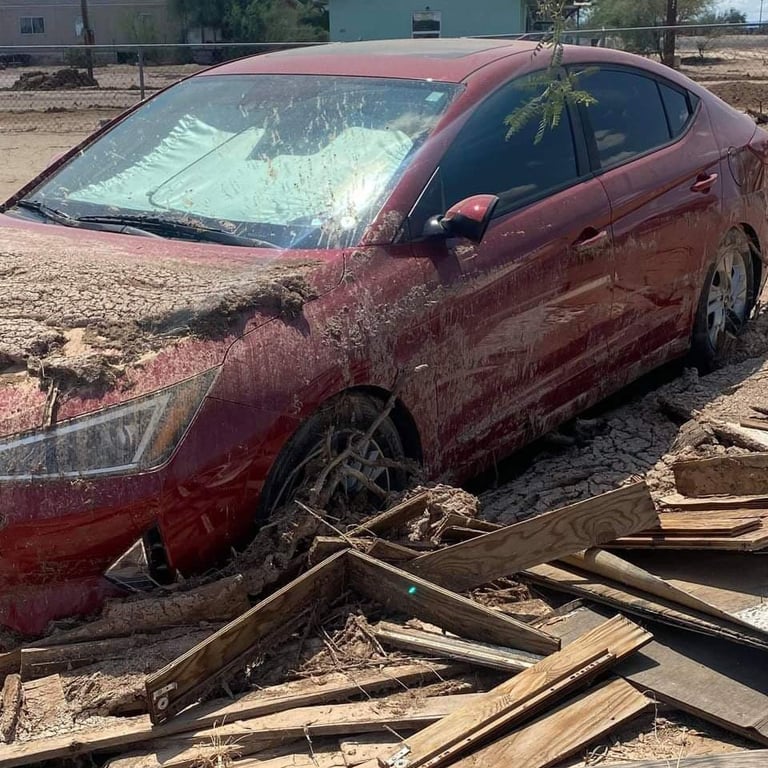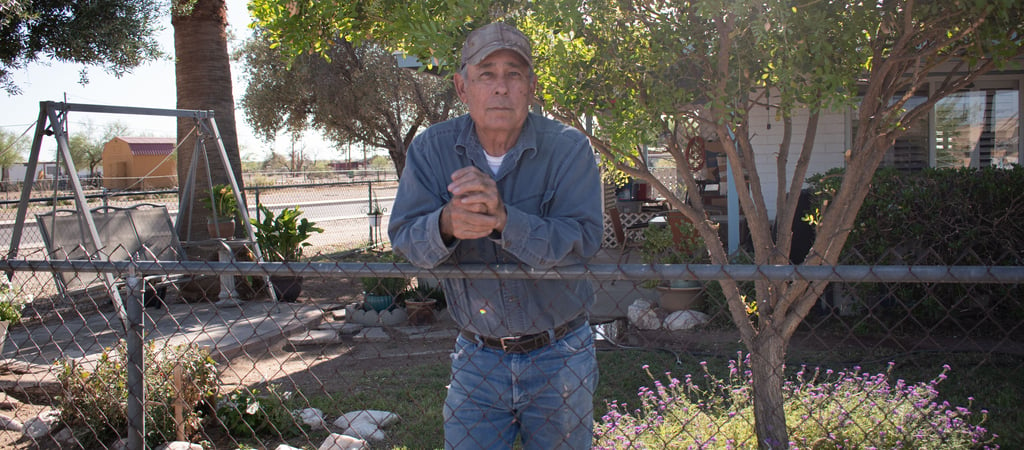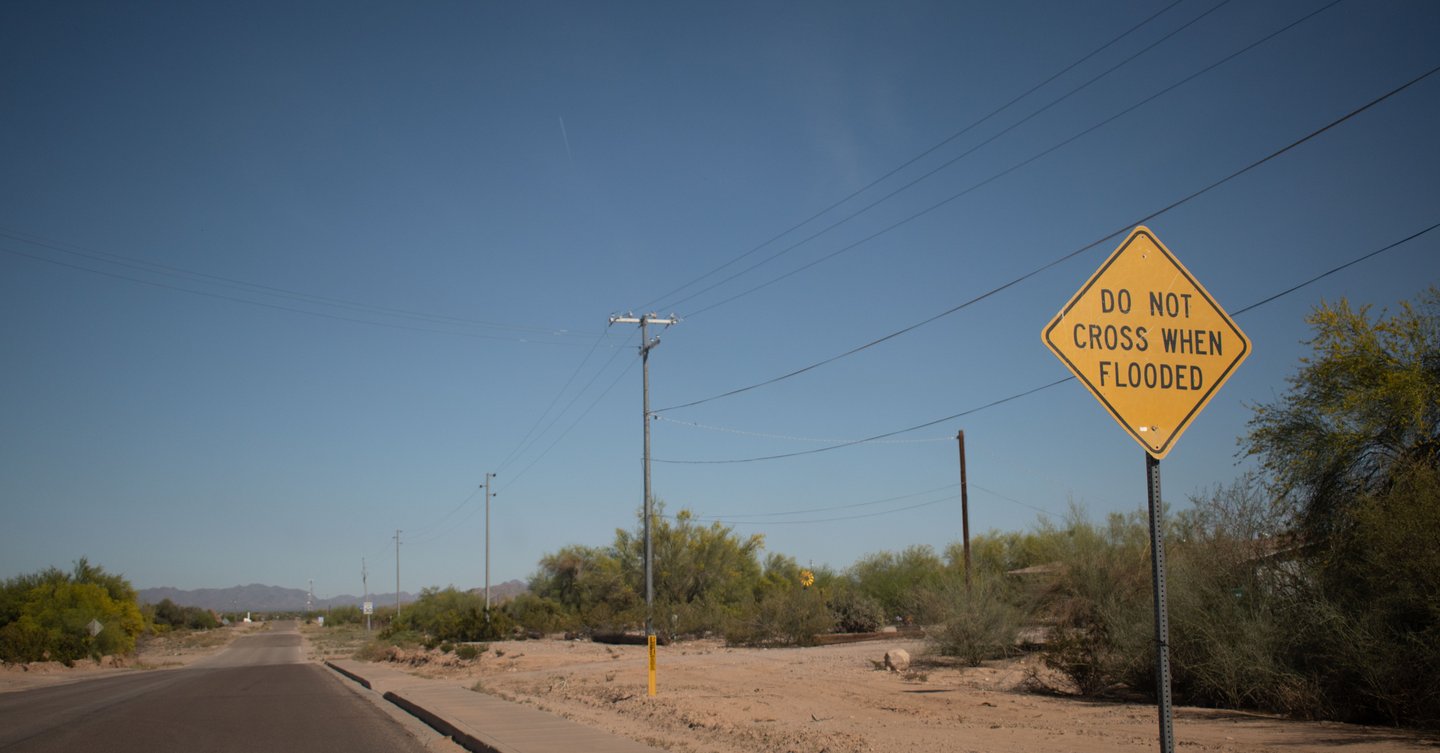Floods overwhelm rural central Arizona towns, whose mitigation plans can’t withstand the changing climate
REPORT
A loud scream in the middle of the night startled Vannessa Vega. It was still dark outside, but her mother had thrown on all the lights as she shouted, "Get out!"
Her mother stood at the front door of the house looking out at the thundering rain and the approaching disaster.Vega hurried toward the door through a puddle of water that was seeping into the room. As she frantically opened the door, a wave crashed into her.
"I was having a panic attack," Vega, 23, said. "But I was also trying to push myself because I had to hurry up and get out."
In the early hours of August 14, 2021, the Vegas were among at least 140 families surrounded by quickly rising water. A day-long rainfall triggered record water flow that flooded the town overnight.
By the time the water subsided, two people had died, and at least 21 families in the predominantly Hispanic neighborhood of south Gila Bend were left without homes for several months. The flood caused an estimated $25 million worth of property damage, according to a report of the event by the National Weather Service, a part of the National Oceanic and Atmospheric Administration.
People living and working in the town said they were not prepared nor had anticipated the devastation.
In contrast, local municipalities for over six decades were aware of the flood risks in Gila Bend, a town of about 1,900 people some 50 miles southwest of Phoenix. The Maricopa County Flood Control District, the agency responsible for reducing flood risks in the county, had long known where and how floods might impact Gila Bend, county records reveal. In area drainage design plans and hydrology study reports, the district discovered the need for flood-mitigation infrastructure.
However, the flood control district failed to act on any of the mitigation action plans.
"A lot of things that we have had over time we lost in seconds because of the water," Vega said.
Flood control projects are expensive. The cost burden is often too high for rural communities, even with cost-sharing provisions. Agencies like the Maricopa County Flood Control District must choose projects that make the most "economic sense," according to a flood control district official.
In Maricopa County and surrounding areas - where significant rainfall events and floods have surged in the last few decades - rural communities are not as protected or adapted as their urban counterparts. Experts warn climate change will further escalate the extreme weather events in the region.
It was a typical Friday night in Gila Bend except for the sightings of thunderstorms slowly moving south from Mogollon Rim and farther north. Flash flood warnings for different parts of the Central Arizona region went into effect earlier. A low-level moisture advection intensified the storm as it reached the town.
Torrential rain pounded areas east and southeast of Gila Bend. From 10 p.m. Friday to midnight, two nearby alert gages recorded 3.78 inches of rain – a one-thousand-year event, according to the flood control district’s storm report.
A rain gauge at the town’s Sand Tank Wash at one point recorded about 5,000 cubic feet of water per second flowing through it. That’s enough water to fill up an Olympic-size swimming pool roughly every 15 seconds. However, later inspections by the district suspected runoff to be of "greater magnitude." An old levee on the wash channel, which bisects the town, broke due to the intense water flow. Breaching the canal, the west-flowing flood water collected mud and debris, rampaging the south Gila Bend neighborhood.
In the last 30 years, the Maricopa County Flood Control District officially assessed flooding dangers in Gila Bend four separate times. In each, hydrologists recommended repair of the Sand Tank Wash as the main flood mitigation necessity for the area.
In the 30 years, the district has not been able to build a single one of the recommended flood control structures, like levees and wash basins. Flood control district officials cited a lack of resources behind the failure to act on the recommendations.
"The impacts we see from flooding are a combination of policies we have and how we've chosen to adapt and where we choose to live," said Beth Tellman, flood researcher and assistant professor of geography at the University of Arizona.
The brewing storm
Arizona is bracing for a warmer future. Since the beginning of the 1900s, temperatures in Arizona have increased by 2.5 degrees Fahrenheit, according to the National Oceanic and Atmospheric Administration. The changing climate may lead to more severe floods.
Arizona is now in a 27-year-long drought, according to the Arizona Department of Water Resources. The wet monsoon months can provide respite to the parched, arid landscape of central Arizona. But, when it rains, it floods.
“Oddly enough, we're expecting more droughts and more floods,” said Thomas Meixner, department head of hydrology and atmospheric sciences at the University of Arizona,
Water cannot penetrate the desert's clay-like soil, according to Meixner.
There were only 15 flash floods in Maricopa County throughout the 1990s, compared to 44 flash floods in the 2000s, according to the National Weather Service that defines flash floods as flooding that occurs mostly within six hours after a high-intensity rainfall.
From 2010 to the end of 2019, Maricopa County was swept by 232 flash floods, an almost 500% increase compared to the previous decade. The current decade is on pace to beat previous records by a wide margin. In just the 2021 monsoon season, Maricopa County experienced 97 flash flood events, according to the National Weather Service.
Meixner concurred with the rate of increase and projected it to continue. “A flood bigger than the one you imagined could come,” he said.
“We expect it to rain fewer days. But when it does rain, it’ll rain more,” Meixner said. “The amount of moisture the atmosphere can hold is exponentially related to the air temperature.”
The National Weather Service data shows central Arizona is receiving a similar amount of rain in shorter bursts and intervals. The National Weather Service recorded 47 heavy rain events – precipitation of two or more inches – throughout the 2000s in the Phoenix area.
The number of flash floods almost doubled a decade later to 91.
"Who would think flood in a desert? I've never seen anything like that," Clarence Mendoza, a lifelong Gila Bend resident, said about the 2021 flood. "The water's never gone that high."
Most people may not be aware that they're susceptible to floods from storms that happen far away, said Erinanne Saffell, director of the Arizona State Climate Office. She said she considers flooding events to be the "riskiest" of all climate-related natural disasters.
Saffell noted yearly precipitation does vary but the long-term trend remained consistent in the Phoenix area. The region, on average, saw 6.52 inches and 6.67 inches of rainfall over the 2000s and 2010s decades, respectively. Saffell considers rising temperatures and wildfires to be an additional source of floods.
“We're dealing with wildfires. Those will affect the soil. They'll remove vegetation, they'll harden the soil because it's getting burned,” she said. “And so we have these areas called burn scars. They're not necessarily in urban locations.”
Getting washed away
Even after recognizing the destruction floods can bring to rural communities, actions to mitigate the risk are hard to come by.
Following the Gila Bend flood, Gov. Doug Ducey declared a declaration of emergency and provided $200,000 for response and recovery efforts. Similarly, the Maricopa County Board of Supervisors approved $500,000 in funding for the town.
It's a relatively smaller price to pay, though. Several studies conducted by the Maricopa County Flood Control District that evaluated potential flood mitigation solutions in Gila Bend proposed improvement projects that costs multi-million dollars.
Administering the recommended mitigation solutions – construction of physical flood control structures – could cost up to $25 million, according to the district Director Michael Fulton.
"It is possible to mitigate much of these risks, but it won't all be mitigated through the building of a structure and channel," Fulton said in an interview.
Fulton alluded that prevention is better than cure, saying hazards should be identified before a community gets building. He added the cheaper alternative would be to remove buildings and people from known floodplains.
The Maricopa County Planning and Zoning Department acknowledged the town's flooding concerns officially in 1960, records show. Areas near the Sand Tank Wash were flooded on July 3, 1964.
In 1992, the FDC with help from Engineering and Environmental Consultants established the first FEMA floodplains in its Area Drainage Master Plan for Gila Bend. The plan called for reconstructing the Sand Tank Wash levee, which was to cost an estimated $750,000.
An update to the master plan was made in 2015. In this study update, the cost of reconstructing the Sand Tank Wash levee had risen to $2.2 million. The 2015 study and the latest one conducted a couple of years later noted three primary flooding sources: Bender Wash, Sand Tank Wash and Scott Avenue Wash.
The assessment determined the South Gila Bend neighborhood as the most impacted flood-prone area. The latest master plan update called the area "low lying and economically distressed."
According to the U.S. Census, the median household income in Gila Bend is slightly more than $30,000. About 68% of Gila Bend is Hispanic.
"We've chosen not to invest and build flood mitigation infrastructure in communities of color," said Tellman, the University of Arizona professor. "And, that has become self-perpetuating because there's been less investment in infrastructure and a lower tax base."
Who gets flood control?
Extreme weather events and natural calamities does not discriminate between urban and rural areas. But when it comes to protection from flash floods, rural communities find themselves more vulnerable.
“White and wealthy communities are able to access more resources, funding,” Tellman said, “And (it) tend to get a lot more after a disaster than communities of color or poor communities.”
In the fiscal year 2020, the district budgeted $85 million for its capital improvement program.
In the fiscal year 2021, the district looked at 13 project requests that were priced at $61 million in total. The district prioritizes projects brought in by various municipal groups through an evaluation procedure. To determine candidates for its capital improvement program, the district ranks projects by forecasted impact, financial commitment and ancillary benefits like opportunities for economic development, among others.
The limited budget at the disposal of the Maricopa County Flood Control District constrains it to prioritize some flood control projects more than others.
"We can't protect it all," said Steve Waters, manager of the Flood Warning Branch at Maricopa County Flood Control District. "It's too big of a county."
A storm drain improvement project at Sun City, an unincorporated area near Peoria, scored the least in the district’s prioritization criteria for fiscal year 2022. The district had to contribute about $1.3 million for it.
The Sun City project received 50 points out of a 100 and failed to qualify. Meanwhile, a project at Elliot Road in Mesa that received 55 points was recommended. The Mesa project will cost the district $2.2 million. Two projects in Scottsdale, costing the district over $7 million in total, found itself high on the prioritization list and got included in the year’s program.
"We do quite a few projects where there's no cost-share involved at all," Waters said. "We don't just stack all the cost-share ones up at the top. But, yeah, it does have an impact on our selection process."
When Ahwatukee Foothills, a neighborhood in Phoenix, was hit by a flood in 2014, the district conducted a study to find mitigation solutions. Ahwatukee Foothills is a relatively wealthy neighborhood, whose ethnic makeup is 80% white. All the recommendations in the study have been applied, according to a district spokesperson. As part of that work, the district built a $1.2 million drainage improvement project, which included the construction of a quarter-mile-long channel that completed in 2021.
Separately, in Scottsdale, Rawhide Wash is taking shape to mitigate the chance of a 100-year flood event. The flood control district will cover 50% of the $16.5-million project price tag. While Phoenix will cost-share 40% of the project cost, the last 10% falls to Scottsdale.
"Who has the influence in government and the voice to decide where that mitigation infrastructure gets built?” Tellman asked, rhetorically. “Oftentimes, someone's flood mitigation infrastructure can cause more vulnerability for somebody else. If you block floodwaters from entering one place, they might go the other direction.”
Less than a week after the Gila Bend flood in 2021, downpours from severe storms along the path of the Telegraph fire burns scar wreaked havoc in Globe, a city located about 90 miles east of Phoenix in Gila County.
Flash floods damaged at least 80 homes, about 40 trailer homes and displaced hundreds of Globe residents.
“It was horrendous,” Globe Mayor Al Gameros said.
The failing McCormick Wash in Globe is currently a bigger disaster waiting to happen. Almost 100 years ago, a tunnel was built to divert water to the wash collected from a dam nearby a high elevation area northwest of the city. The tunnel has eroded over time.
“If that tunnel were to collapse, or close off, it would divert the water back to the dam,” Gameros said. “The dam is not going to hold the water and it's going to end up in our downtown area.”
The city estimates fixing the tunnel and McCormick Wash would cost upwards of $5 million. Gameros said the city was in contact with Gila County Flood Control District as well as the state in relation to the project.
But getting the ball rolling was challenging.
“For rural communities, it is a challenge,” he added. “We don't have the big money that Phoenix and Tucson and all the big cities have.”
A year ago, Globe hired two lobbyists to bring attention to the city’s issues in Washington D.C. The omnibus appropriation bill passed in April by the U.S. Congress included $100,000 for repairing Globe’s McCormick Wash.
It’s only the first step, though. The initial federal funding will be used to study the problem and devise a mitigation plan.
“People don't see the aftermath of the flooding that takes place and that's the thing we're fighting now,” Gameros said about the destruction from floods. “We need to be prepared and there's only so much we can do.”
Vega, the Gila Bend resident whose family spent about six months in a motel following the August flood, could not evade the flood.
Earlier in the night, before the flood took her car away, Vega was trying to drive into the town center to buy some snacks. Around 11 p.m., the channel that separates the town into north and south had already started to overflow with water. The road was un-drivable, so she returned empty-handed and trapped inside the neighborhood.
"There was no way to get out of the south side," Vega said.
South Martin Ave. is the only road that connects the south Gila Bend neighborhood, which Vega said is a majority Spanish-speaking community, to the rest of the town. All businesses, schools and civic centers lie on the northern half of the town.
Gillespie Dam, constructed in 1921 on the Gila River, helped irrigate farmlands in Gila Bend. Agri-businesses and the ranching industry grew in the subsequent years. [Alfalfa, cotton, barley and other crops still grow near the riverbanks.]
Most of the people who worked the fields settled in Gila Bend’s south side, according to some residents.
When the water got too high on the morning of August 14, Vega collected valuables she could fit on her hands, like her cell phone and her pet chihuahuas, Ashton and Chiquito. She then joined the rest of her family in climbing on top of the house's roof.
“It was, I would say, very traumatic,” Vega said.
Vega and 30 other individuals escaped from their south Gila Bend homes on helicopters, brought in by the Maricopa County Sheriff's Office.


Destruction from the August 2021 flood at a south Gila Bend house (Courtesy/Vannessa Vega)
– – – – –
On August 13, 2021, south Gila Bend resident Clarence Mendoza went to sleep at his usual time. Deep in sleep, Mendoza woke up to the sharp ring of his cell phone. It was his sister, who lived a few blocks, calling for help.
“She’s crying that there’s water in the house. I thought she had a water main burst or something inside her house,” Mendoza said. “She said, ‘No, there’s water up to my knees.’"
Because his house is situated at a slightly higher elevation than the rest of the neighborhood, the floodwaters could not reach Mendoza.At present, his house is one of the few that still stands in good shape. Most of the houses in his south Gila Bend neighborhood have been disfigured. Many neighbors evacuated during the flood and never returned. Gila Bend is quieter ever since the flood.
At his white, one-story house on a corner lot, Mendoza now spends his retirement tending his lawn and pondering how things unfolded.
"One of the things I can't believe is why somebody didn't see. They got all this technology for weather [prediction]," Mendoza said. "They should have seen it coming."
On a recent sunny spring afternoon, Mendoza stood in his front yard with a garden hose coiling across the luscious green grass full of potted plants. He inspected his purple petunias, dusted it off gently, and continued watering.Mendoza waits to welcome back his neighbors. He's not looking forward to the coming rainy seasons.


Clarence Mendoza stands in the front yard of his house in Gila Bend. (Neetish Basnet)


A roadside sign warns of flood dangers in a dusty, dry part of Gila Bend. (Neetish Basnet)

